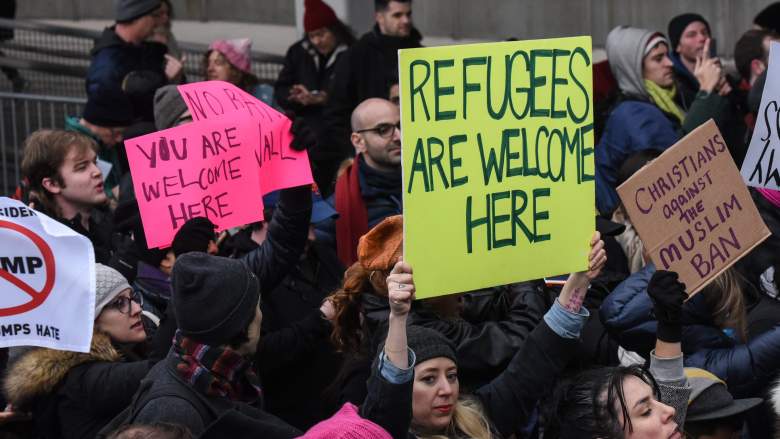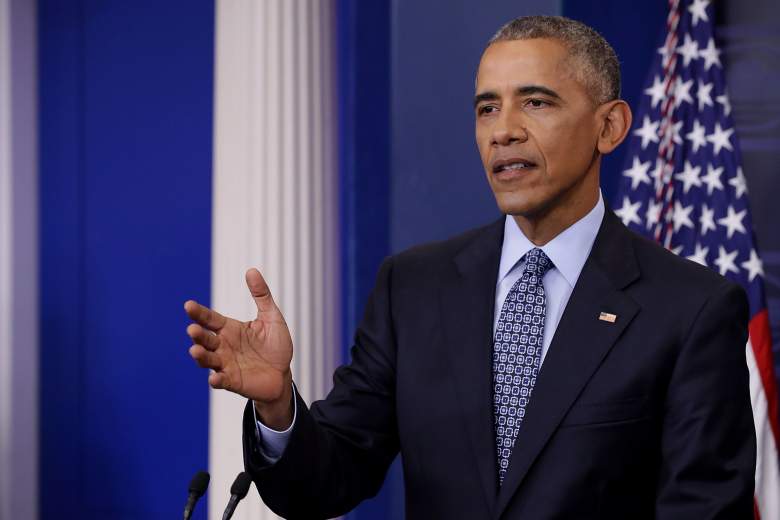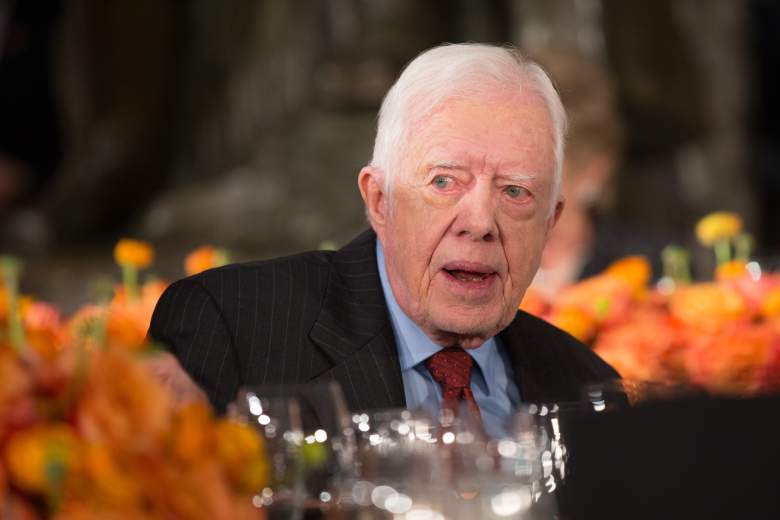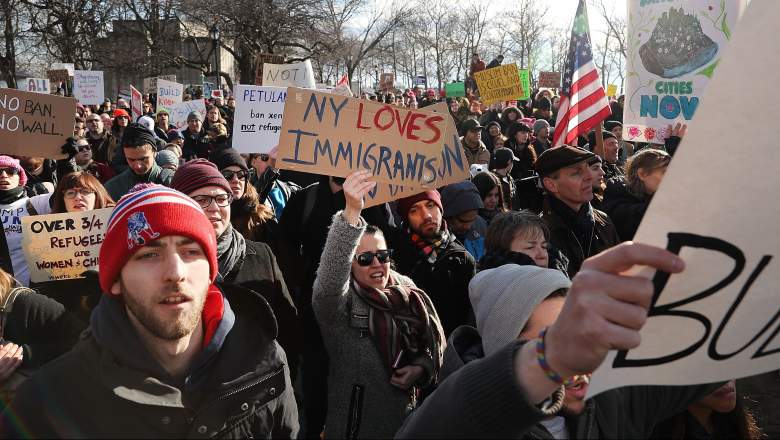
Protestors rally during a demonstration against the Trump immigration ban at John F. Kennedy International Airport on January 28, 2017 in New York City. (Getty)
In the furor against President Donald Trump’s ban on immigration, some are bringing up history.
Did President Barack Obama also ban refugees from Iraq?
A 2013 ABC News article reported, “The State Department stopped processing Iraq refugees for six months in 2011, federal officials told ABC News – even for many who had heroically helped U.S. forces as interpreters and intelligence assets.” The ABC News expose is the source of most claims that Obama “banned” or “stopped” Iraqi refugee immigration for a time after two Iraqi refugees who had also been to Syria were indicted on terrorism charges in Bowling Green, Kentucky.
However, The Washington Post reported that a former Obama administration official named Jon Finer has “denied that any ban in Iraqi refugee admissions was put in place under Obama.”
“While the flow of Iraqi refugees slowed significantly during the Obama administration’s review, refugees continued to be admitted to the United States during that time, and there was not a single month in which no Iraqis arrived here,” Finer wrote in Foreign Policy. “In other words, while there were delays in processing, there was no outright ban.” Another official backed up Finer’s account to the Post.
The Post did reprint this 2011 exchange between Republican Senator from Maine, Susan Collins, and then Homeland Security Secretary Janet Napolitano as to whether “a hold had been placed on Iraqi visa applications.” Collins asked at the congressional hearing: “So my question is, is there a hold on that population until they can be more stringently vetted to ensure that we’re not letting into this country, people who would do us harm?” Napolitano responded,
Yep. Let me, if I might, answer your question two parts. First part, with respect to the 56, 57,000 who were resettled pursuant to the original resettlement program, they have all been revetted against all of the DHS databases, all of the NCTC [National Counter Terrorism Center] databases and the Department of Defense’s biometric databases and so that work has now been done and focused.
Trump’s executive order stops all Iraqi citizens from temporarily entering the U.S. “on any visa category,” affecting those trying to visit family or come here for work, in addition to live. It also affects six other countries. It originally included permanent legal residents of the U.S. with green cards, but the Department of Homeland Security later clarified that green card holders would be allowed into the country.
While Obama did slow the refugee program, it did not impact green card holders, or anyone with a visa. It also did not affect refugees who had already gone through the vetting process. Trump’s travel ban initially barred entry to the United States to those groups, causing a chaotic situation for travelers from the seven affected countries and leading to protests at airports across the country.
“Obama’s policy did not prevent all citizens of that country, including green-card holders, from traveling the United States. Trump’s policy is much more sweeping, though officials have appeared to pull back from barring permanent U.S. residents,” the Washington Post reports.

Obama during his final press conference as President. (Getty)
Trump’s order gives preference to religious minority groups, such as Christians, when the admissions resume, according to The New York Times.
Obama didn’t give any preference to religious minority groups, and his action was limited to refugee resettlement (certainly, it didn’t affect green card holders, for example). However, Obama’s slowdown in Iraqi refugee admittance had consequences for some people and was driven by the terrorism case involving refugees, ABC News reported. The network reported that, as a result of the delays, an “Iraqi who had aided American troops was assassinated before his refugee application could be processed, because of the immigration delays.” (One of the first men detained under Trump’s executive order, Hameed Darweesh, was an Iraqi interpreter for the U.S. military. He has now been released under an exemption in the order.)
Trump raised the Obama situation in a January 29 statement defending his immigration executive order. He wrote, “My policy is similar to what President Obama did in 2011 when he banned visas for refugees from Iraq for six months. The seven countries named in the executive order are the same countries previously identified by the Obama administration as sources of terror.”
Others dispute Trump’s contention that his order is similar to Obama’s.
Why did Obama’s administration slow processing the applications?
It stemmed from the case out of Bowling Green, Kentucky. According to the Associated Press, “Two Iraqi refugees plotted to send sniper rifles, Stinger missiles and money to al-Qaida operatives waging an insurgency back home against U.S. troops.”
Waad Ramadan Alwan and Mohanad Shareef Hammadi were accused in the plot. ABC reported at the time, “Several dozen suspected terrorist bombmakers, including some believed to have targeted American troops, may have mistakenly been allowed to move to the United States as war refugees.” Among them, said ABC, was Alwan: “The Iraqi had claimed to be a refugee who faced persecution back home,” but his fingerprints were found on a piece of cordless phone wired to a bomb. Court documents show that the men admitted trying to blow up U.S. soldiers with IEDs in Iraq, and one said he’d participated in an attack that killed American service members. Trump’s adviser, Kellyanne Conway, provoked controversy when she referred to the Bowling Green plot as the “Bowling Green massacre.” The men were indicted, and ultimately convicted, before they could cause any havoc on American soil, and charging documents show they were accused of trying to funnel weaponry back to insurgents based in Iraq.
As a result of the case, though, the government decided to check IED devices for fingerprints, according to ABC. More stringent vetting procedures were created. The Department of Justice press release announcing the two men had been sentenced quotes the U.S. Attorney as saying of them: “These are experienced terrorists who willingly and enthusiastically participated in what they believed were insurgent support operations designed to harm American soldiers in Iraq.”
The Mirror describes what Obama did this way: “Paused approvals of refugee applications from Iraq for a period of six months after two Iraqi al-Qaeda terrorists were discovered living as refugees in Kentucky.” The news site says Obama’s action was in response to a “specific event” and designed to give authorities time to do the fingerprint matches off recovered IEDs.
But the Post wrote that it could find no evidence of a ban outside the ABC News article. In a fact check, the Post wrote, ” Obama did not announce a ban on visa applications. In fact… administration officials danced around that question. There was certainly a lot of news reporting that visa applications had slowed to a trickle. But the Obama administration never said it had a policy to halt all applications. Indeed, it is now clear that no ban was put in place. Even so, the delays did not go unnoticed.”

Anti-Trump protesters at JFK airport. (Getty)
According to National Review, President Obama also admitted very few Syrian refugees during his tenure overall, although the pace escalated in his final year.
There was some precedent for immigration restrictions in U.S. history based on nation state. In 1980, according to Politifact, Jimmy Carter “ordered administration officials to ‘invalidate all visas issued to Iranian citizens for future entry into the United States.'”
Here’s specifically what Carter said in his address announcing those sanctions: “…the Secretary of Treasury [State] and the Attorney General will invalidate all visas issued to Iranian citizens for future entry into the United States, effective today. We will not reissue visas, nor will we issue new visas, except for compelling and proven humanitarian reasons or where the national interest of our own country requires. This directive will be interpreted very strictly.”

Former U.S. President Jimmy Carter. (Getty)
The Carter measure came in the height of tensions over the Iran hostage crisis. Carter also ordered Iranian students to report to U.S. immigration. Trump’s order affects more countries but appears also tailored to nation states rather than the religious test he floated during the presidential campaign. However, because they are all Muslim majority and some minority religions are exempt from the ban, some are criticizing Trump for ordering what they are deeming a “Muslim ban.” See the language in the order relating to that point here:
Trump denies that his order amounts to a Muslim ban, saying in a statement that 40 Muslim majority countries throughout the world are not affected by his executive order. He has argued that religious minority groups are singled out for persecution in the affected countries.
The courts will ultimately decide.
Pew Research noted that “after the 2001 terrorist attacks, the U.S. largely suspended refugee resettlement for about three months while security measures were examined.”
As for President Chester Arthur, in 1882, he “signed the Chinese Exclusion Act, which stopped Chinese immigration for 10 years…The ban also prevented Chinese persons from becoming U.S. citizens, and the exclusion was subsequently extended permanently through later legislation,” reported ABC News.
In 1917, during World War I, Congress passed legislation that barred “most Asian nation immigration overall, with the exception of Japan…and the Philippines,” according to ABC News, which added that the U.S. only allowed 105 Chinese people to move to the country each year until 1965. In several immigration acts in the 1920s, reported ABC, the country established “a wide-scale quota system based on national origins.”
Trump’s immigration ban – which has been met by intense criticism and protests at airports throughout the country – temporarily stops immigration from six Muslim-majority countries: Iraq, Iran, Somalia, Sudan, Yemen, and Libya. The order also indefinitely stops immigration from Syria, stops all refugee resettlement for 120 days, and caps 2017 refugee admittance to 50,000.
A federal judge granted an emergency stay for part of the executive order on January 28, ruling that the government could not send back immigrants from the affected countries who are at airports being detained because they might suffer irreparable harm. A lawsuit has been filed asking the courts to deem the entire Trump executive order unconstitutional under the 5th Amendment, contending it subjects Muslims to disparate treatment. The Trump order had also affected people with green cards and those visiting America to see family or for work; there is a provision for case-by-case exemption in some circumstances. There have been reports of students, professors, and others stuck overseas or at airports who had lived in the United States for years.

People attend an afternoon rally in Battery Park to protest U.S. President Donald Trump’s new immigration policies on January 29, 2017 in New York City. (Getty)
According to Mic.com, the countries Trump selected for his executive order derived from a previous list created by Obama, although the president was only restricting access to a visa waiver program: “The countries whose citizens are barred entirely from entering the United States is based on a bill that Obama signed into law in December 2015. Obama signed the Visa Waiver Program Improvement and Terrorist Travel Prevention Act as part of an omnibus spending bill. The legislation restricted access to the Visa Waiver Program, which allows citizens from 38 countries who are visiting the United States for less than 90 days to enter without a visa.”
National Review says that, before 2016, “when Obama dramatically ramped up refugee admissions, Trump’s 50,000 stands roughly in between a typical year of refugee admissions in George W. Bush’s two terms and a typical year in Obama’s two terms.”
The New York Times reports that about the same number of Christians and Muslims were admitted to the U.S. as refugees in 2016, despite Trump’s claims that Christians had basically no chance to get asylum under President Obama.
According to Pew Research, Obama allowed in relatively small numbers of refugees from the affected countries, although the pace increased in 2016. The numbers are still relatively small. For example, in 2016, Obama allowed in 12,587 refugees from Syria; 9,880 from Iraq; 3,750 from Iran; and 9,020 from Somalia. The Congo had the largest number of refugees admitted to the U.S. in 2016, Pew Research found.
A 2016 Fox News report found that Congressional data revealed “hundreds of terror plots have been stopped in the U.S. since 9/11 – mostly involving foreign-born suspects, including dozens of refugees.” The report noted that some of those involved refugees from the affected countries, but other countries had more (Pakistan was top), and some terrorist suspects were born in America.
Learn more about Carter and Iranian visas here:

